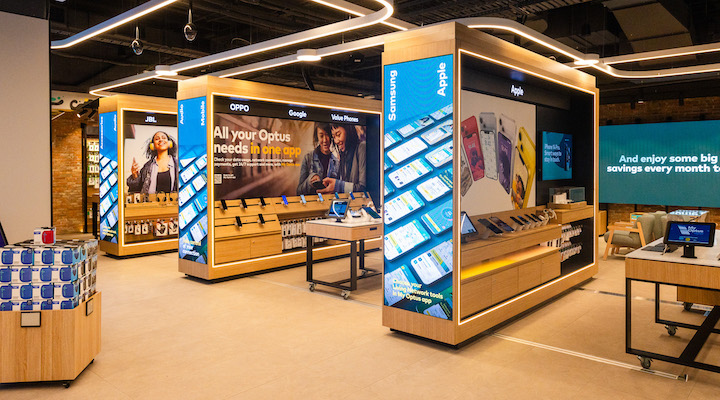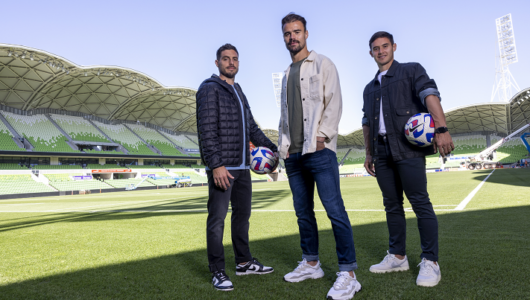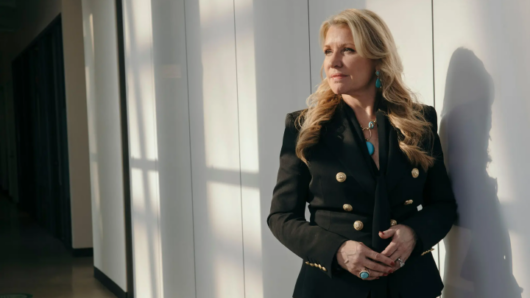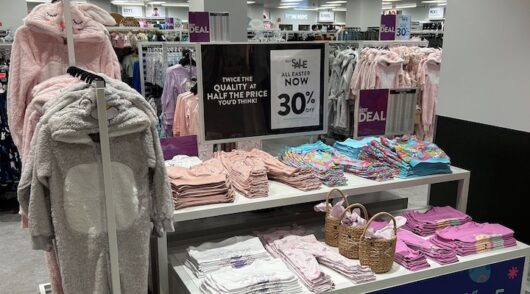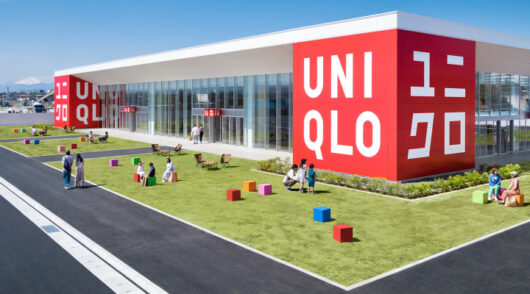As consumers actively seek out more experiential retail engagement, brands are increasingly looking for ways to integrate digital signage in stores.
In a stunning example of the trend, a new Optus store that opened in Melbourne’s Bourke Street last month featured 63 screens throughout the store, installed in a partnership between Google Chrome Enterprise and Australian end-to-end digital signage agency Entwined.
But it’s important to understand that such signage is not just about entertaining customers and demonstrating products or brand partnerships, explains Entwined founder and co-owner Cameron Hanns. “In-store digital signage is equally impactful in driving increased sales and reducing store overheads for retailers.”
“In the past, digital signage has very much been ‘let’s put a TV here and some LED here’ but those days are over,” adds Natalie Layton, Entwined’s key account manager. “It’s all about strategy, innovation and giving the customer a journey that’s going to create an emotive reaction for a customer.”
Today, there is a growing opportunity around connecting the in-store retail media piece of the broader marketing puzzle, continues Hanns.
“We have been working with our customers on how we connect the store part of their retail media into their omnichannel marketing approach. Step one of that is you need to install a digital signage presence in your stores.
“We’ve worked for years with customers around how to deliver a sale message, a brand message, a corporate social responsibility message, a membership message – we’ve worked with their content teams about how to get the best out of their signage.”
Early adaptations of digital signage were often very much about replacing print to get a return on investment, with Lotteries Corporation, a great example. When Entwined first took over the account, the company had five games in the market and was shipping printed material to 4000 sites three times a week.
So there’s an obvious and real return on investment from converting to digital around cost saving in printing and fuel, for a start. Using Google Chrome Enterprise, creative for digital signage can be delivered simultaneously to all 4000 stores via the internet, then configured and adapted whenever needed from a central facility run by the marketing team.
Hanns says that during the past four to six years, Entwined’s customers have grown to understand how digital assets can do much more than just replace printed signage and they are now working with Google Chrome Enterprise as an enabler to unlock ways of boosting engagement with customers and increasing sales.
“Lotteries Corporation says that on Jackpot days, sometimes it will sell 50 per cent of the tickets in the 24 hours leading up to a jackpot and that’s driven by their digital signage.
“In the quick-service restaurant (QSR) space, we know that upwards of 95 per cent of people who enter a store will purchase from it and we know that we can heavily influence what they buy through value, through bundling and through trade-up algorithms – by knowing that 90 per cent of the people who buy one specific product, will buy another as well if it is put in front of them,” Hanns says.
“What we’re seeing now is the evolution of retail media which for us was an expansion of the true omnichannel journey that’s been talked about for a long time, but hasn’t really been able to deliver.”
Key to the success of digital signage as a medium is analysis of customer behaviour. On a website or an app, a company can easily measure click-through and how the customer behaves on the shopping journey. But it has traditionally been a lot harder to assess that behaviour in a physical store.
Until now, Hanns says, a retailer could have been using the same advertising campaign in stores as it used in television campaigns to encourage them to visit a store, but been unable to assess the performance of each in a way that campaigns could be fine-tuned, or offers added to optimise future promotional strategies and thus sales.
Digital signage can go a step further for retailers by creating an additional revenue stream by partnering with brands the stores sell.
For example, savvy retailers can work with trade partners to take traditional in-store campaigns a step further. While brands have often funded promotional campaigns for specific brands, there’s never been a really clear commercialisation of it, he says. By analysing consumer responses to promotions online and via apps, and applying the learnings from that to how in-store media is delivered, stores and their brand partners can optimise conversion rates by displaying the best messages in the right places in stores at the right time of the day.
Retailers embracing that approach will use the retail media network that runs their online ads and their apps and extend that network to include in-store retail. The message is running from a browsing environment right on to the display cabinet in the store where the point of decision occurs.
“If you’re talking to someone at the point of sale, they’ve already made their mind up. With in-store retail media you are actually influencing and talking to your customer and the brands themselves can get to talk to the customer at the point of sale. So Nike, for example, can got to a sports retailer like Rebel and buy space to explain the brand’s sustainability commitment or about social responsibility, or about why athletes choose a product.”
For any store that stocks multiple brands, such as pharmacies or supermarkets, being able to commercialise the influence at the point the customer makes a final purchasing decision is huge, says Hanns. “This trend is helping the retail media industry is building out a new category of marketing spend.”
Traditionally deals between brands and retailers have focused on incentives, like rebates when certain unit sales volumes have been reached, which tend to get lost in a retailer’s profit and loss.
“Now we are seeing those conversations mature into how you can influence a sales cycle or you can influence a competitor’s offer if you invest in this space. It’s real virgin ground in that sense. There’s a whole new way of talking about how Nike or Under Armour, for example, can talk to the customer once the customer is inside a store.”
“As social and other verticals evolve, even just modelling what’s happening on social channels has become really difficult because it is difficult for clients or brands to connect with their customers and they have to be everywhere,” adds Layton. “They can’t necessarily see a return on investment, but they know they have to be there and that their campaigns need to change all the time – especially on social – to get and gain traction.
“But when customers are in the store, they have their attention. There are just brands in front of shoppers that they can engage and connect with, and this is why brands are looking at retail media. They’re not just throwing something at customers to see what sticks.”
Working with Coca-Cola Euro Pacific on a digital project in the stores of sell-through partners since 2019, Entwined has developed digital menu board solutions that continuously evolve in response to analysing customer response and trialling special content. “We have increased beverage sales significantly in most sites,” says Layton “So it’s about using data through point-of-sale systems, by understanding neuromarketing and how certain images complement different customers. Working across different verticals – whether that’s QSRs, bakeries or fish and chip shops – we have been working out the best way to communicate with customers to increase sales by positioning the product at the right price, but ultimately increasing profits as well for those individual outlets.”
To learn more about how Entwined works with Google Chrome Enterprise to energise the customer and employee experience in stores, take a look at this article.

